As mentioned (and perhaps coined?) in my recent review of Thrones of Valeria, we are in the midst of a magnificent Trickaissance. There has been an absolute boom in games that rely on the primary mechanic of “trick-taking,” or the adjacent mechanic of “ladder-climbing.” If you’re interested in why that may be, there’s an excellent article by Chris Wray that digs into that question over at The Opinionated Gamers which will explain the phenomenon better than I could.
Before we continue, let’s define a few terms. Trick-taking is the easier to define of the two, as versions of this game have populated our leisure time since we were kids. If you’ve ever played Bridge, Hearts, Spades, or Euchre, you’ve played a trick-taking game. If you haven’t, the central concept is simple: a player “leads” with a card of a certain suit, with subsequent players needing to “follow,” i.e. play a higher card of the same suit if they hope to win the hand. One suit may be designated as a “trump” suit, meaning it will trump, or beat, a card of any other suit. One card played from each player adds up to a “trick,” and whoever wins it, “takes” it, hence trick-taking.
Ladder-climbing games, sometimes referred to as “shedding” games, while not necessarily quite as familiarly imprinted upon our childhood brains, come in the more recently familiar forms of Tichu and Scout. The central mechanic here is trying to “shed” all of your cards before your opponents. This is done by playing increasingly larger or higher value groups of cards, often referred to as “melds.” Melds are usually some version of identical card values (pairs, three-of-a-kind etc.), runs (3-4-5-6, etc.), or flushes (all the same suit). In some games, such as Tichu, a person may play a run of four cards, and to beat this would require a subsequent player to play a higher run of four cards. This continues until one player plays a meld that cannot be beaten, all other players pass, the cards are cleared, and the winning player gets to start a new meld.
This will not be a traditional top 10 where I count down from 10 to 1. All of these games are #1 in my heart. But quite frankly, some of them also suck at the wrong player count. So I will be calling out my favorite games by player count. Hopefully, that will arm you with the right game for the right occasion, rather than struggling through a suboptimal player count.
Note: There is an excellent Youtube channel called Taylor’s Trick-Taking Table. Taylor has deep knowledge of most trick-taking and ladder-climbing games, both common and obscure, and if you hear about one, chances are he’s got an entertaining video explaining the rules. It’s been an incredibly valuable resource in figuring out if I’m going to like a particular game, and he’s got a video about nearly every game I discuss below.
Lastly, I will not be including Brian Boru in this list. It’s a great damn game, and we’ve said as much, but while trick-taking is its central mechanic, it’s more a Euro game with trick-taking characteristics than anything else. But play it, it’s good. Ok, on with the list.
2 Players
Haggis
Haggis is a classic ladder-climbing/shedding game built for two players by Sean Ross, almost an archetypal game of the genre. It was originally released in 2010 by Indie Boards & Cards. Similar in many ways to Tichu, each player alternates playing higher versions of a meld, with certain cards worth points, while others are worthless. Each player starts with three face-up wild cards that they can employ at any time to either complete a meld or even play as a “bomb” (a specific meld that usually ends the hand unless a higher bomb is played). The game features an excellent push-your-luck element wherein players bid a certain number of points at the beginning of each hand, gaining those points if they shed out first, or giving those points to their opponent if they don’t. While the Indie Boards & Cards version is out of print, a new version is in the works from trick-taking aficionados Portland Game Collective, who recently published the excellent Five Three Five and Bridge City Poker. The community PGC has built around their Discord channel feels very much like the epicenter of trick-taking in the US and even abroad.
2-3 Players • Ages 10+ • 45 minutes

Jekyll vs Hyde, by Korean designer Geonil, pits two players against each other in a competition for the soul of Dr. Jekyll. Will he remain the moral and honorable doctor, or will he transform into the hideous and evil Mr. Hyde? This is a trick-taking game wherein the two players have asymmetrical goals. Between the two players is a board with what is essentially a sanity track. A pawn moves in one direction: from the Dr. Jekyll end toward the Mr. Hyde end. The Mr. Hyde player’s goal is for one player—it does not matter which one—to win significantly more tricks than the other, because the distance the pawn moves towards Mr. Hyde’s end of the track is equal to the difference between the won tricks (i.e. one player wins 7, the other wins 3, hence the pawn moves 4 spaces). Dr. Jekyll’s goal is for each player to win exactly the same amount of tricks so the pawn does not move. There are three suits, and rather than one suit being trump, the three suits are ranked in power from lowest to highest, and this ranking is determined during the round. Add in the wrinkle of special ability potion cards that can change the game state mid-round, and you’re bound to go mad over this beautifully concocted 2-player trick-taker.
2 Players • Ages 10+ • 30 minutes • $22
Honorable Mention: Bridge City Poker, Fox In The Forest
3 Players
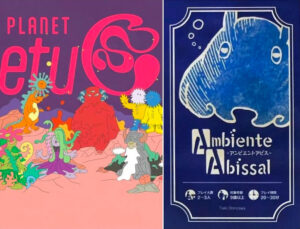
There are many great ladder-climbing games by the trick/ladder GOAT Taiki Shinzawa (think of him as the Reiner Knizia of Japanese trick-taker/ladder-climbers). Maskmen is a readily available one published by the delightful Oink Games, one that could have easily made this list. But I have never played a game quite as clean in its execution, delightful in its artwork, and easy to explain as Shinzawa’s Ambient Abissal. The main hook of Ambiente Abissal (or its soon-to-be-released reimplementation Planet etuC) is that players can choose to play cards that climb on numerical rank, OR by color. If the ladder hasn’t been established yet as a rank- or color-based ladder, the following player can choose. It’s a really cool concept that seems incredibly simple but makes for a truly rewarding gaming experience. Quite frankly, I would call this the overall best climbing game I’ve played. The original Japanese version was never easy to find even when it was “available,” but now it’s nigh impossible. Luckily, it’s getting this Planet etuC reimplementation. While this too is a Japanese publication, it should be more attainable via certain specialty shops such Tanuki Games in Austin, or Big Cat Games in San Francisco.
2-3 Players • Ages 9+ • 20-30 minutes
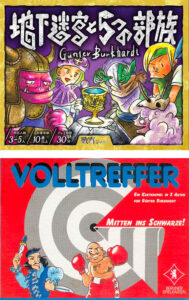
While Volltreffer (Bullseye in English) was originally a German design and publication from 1999 by Günter Burkhardt, the only currently in-print version is a Japanese edition that goes by the laborious name Underground Labyrinth and 5 Tribes. This is an amazing multi-dimensional game that features trick-taking, hand-drafting, and set collection. Players spend points to draft eight cards which they will score for sets of three, four, or five cards of the same rank, as well as having one of each of the five suits. Then players engage in a round of trick-taking, play their hands, and score points for each won trick. The real joy of this game is that the players are actually aiming for a range of points from 61-70. The closest to 66 points wins, but if you are outside the range for 61-70, you cannot win. If you overshoot it, you have to keep going up and swing back around to a lower point value to try to make another pass at that Goldilocks zone of 61-70. The artwork of the newer Japanese edition is by the wonderful Sai Beppu, who I compare to Ian O’Toole, not because she has anything in common with his style, but because she is the most ubiquitous and in-demand artist in the Japanese trick-taking world. She is illustrating the new PGC version of Haggis mentioned above. Read more about her here.
3-5 Players • Ages 10+ • 30 minutes
Honorable Mention: Schadenfreude, Five Three Five
4 Players
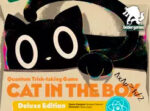
This was the “Shot Heard ‘Round the Convention Hall” at last year’s Gen Con that signaled the start of the Trickassaince for many people. Cat in the Box was undoubtedly one of the most talked about games of Gen Con 2022. Also a Japanese design (seeing a trend here?) by Muneyuki Yokouchi, Cat in the Box asks the age old question of “what if the cards were just the suits that you said they were?” The game is based on the concept of Schrodinger’s Cat; the idea that you cannot know the state of something unless you observe it. In a mind-bending twist, all the cards appear to be black, but in fact, when you play a card, you are claiming it to be a specific suit/color (“this five is a BLUE five”) after which you mark on the central grid that that specific number and color combination has been played, meaning no one else can play it. You can at any point decide that you do not have a specific color in your hand, opening yourself up to play a color other than the one that was led, including the red trump color. However, if you do, you must mark on your player board that you do not have that color, and therefore, for the remainder of that hand, you may not play a card of that color. If a player can no longer play a card into a trick, they cause a paradox and the round ends. Luckily, unlike many Japanese trick-takers, this game was recently republished by Bezier Games and is readily available in the US of A.
2-5 Players • Ages 10+ • 20-40 minutes • $29

Yokai Septet (say it with me… A JAPANESE DESIGN) is the only team-based trick-taker that I’ve included in the list, because team games can really be hit or miss. Some people love them, some people get divorced. Tichu, a classic ladder-climbing team game, could have easily made the list, and briefly did before I kicked it out in favor of this little treasure. In Yokai Septet—by Muneyuki Yokouchi of Cat in the Box fame—teams must capture tricks that contain yokai (or evil demons), all of which bear the number seven. Each of the seven suits have seven cards, but each suit has a different number range, essentially 1-7, 2-8, 3-9, all the way up to 7-13. One suit is designated as trump each round, and each team must capture four of the yokai before winning seven tricks. The round ends when one team has captured 4 yokai (good for them) or won seven tricks before capturing 4 yokai (bad for them). Each yokai is worth one or two points, with the winning team being the only to score. First to seven points wins. That’s it, and it’s goddamn marvelous. Luckily, this Japanese game is readily available in the US, and can be purchased directly from the US publisher, Ninja Star Games.
3-4 Players • Ages 8+ • 30-45 minutes • $19
Honorable Mention: Tichu, Ghosts of Christmas, 9 Lives
5 Players

If Cat in the Box was the “Shot Heard ‘Round the Convention Hall,” then Scout was the “Spiel des Jahres Nomination Heard Round the World.” While ultimately the honor of that award went to Cascadia, Japanese publisher Oink’s first nomination for the prestigious German award sent ripples through the gaming community, and Scout remained #1 in most peoples’ hearts. The board gaming community frequently values and rewards production and complexity over elegance and simplicity in gaming (exemplified by the middling reviews and ratings often given to trick-taking games on Board Game Geek), so for scrappy little Scout to gain the approval of their larger beer-swilling, bratwurst-chomping German brethren was a breath of fresh air. Scout’s concept is wonderfully simple. You are dealt a hand of cards with one number on the top of the card, and a different one on the bottom. You cannot change the order of the cards within your hand, but you may choose to the orientation of your hand, i.e. you may choose if you want all the top numbers or all the bottom numbers. Then you play melds to the center of the table, trying to shed your hand first. On your turn you may: 1) “show,” which means playing a higher ranked meld, beating the previously played one and claiming those cards as points, 2) “scout” off the previously played meld, which means taking one of the cards positioned on the outside of the meld and slotting it – in a position and top/bottom orientation of your choice – into your hand, or 3) using your once-per-round ability to both “scout” and “show.” Scout actually plays well at all player counts, but sings at 5. It’s a wonderful game, and its popularity is no surprise, making it an excellent ambassador for the genre.
2-5 Players • Ages 8+ • 15 minutes • $23

Boast or Nothing is a Korean trick-taking game designed by Yeon-Min Jung, and features, hands down, the most deliriously silly and hilarious artwork of any game. Weird anthropomorphic speech bubbles with mustaches? Scenes of this boastful speech bubble sitting on the Throne of Heaven?? Toilet paper rolls made of cash?! What the hell is going on here? It’s truly bizarre and makes me feel like a 10-year-old child reading an issue of Mad Magazine from the 80s, laughing while having no clue what the joke is. Anyway, like Thrones of Valeria or the aforementioned Jekyll & Hyde, the three suits are ranked, as opposed to there being one trump suit. The suit ranks shift after each trick depending on which suit won the trick. Players must either win a specific number of tricks based on the player count (three for three players, two for four players, one for five players), or win zero tricks. If you win zero tricks you get two points, if you win the correct number of tricks, you get one point, and if you win anything other than that, you get nothing. First player to five points wins. The deck also includes a number of “pass” cards, allowing you to avoid winning a trick if you’re sitting at zero or whatever number you’re supposed to have won. The game is really solid, but the silly art absolutely makes this a real winner.
3-5 Players • Ages 13+ • 15-30 minutes
Honorable Mention: Mu, Voodoo Prince
6 Players or More
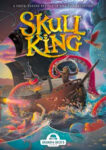
Skull King is a bidding-based trick-taker that accommodates a large group really well, with a few interesting curves thrown in. The number of cards each player gets dealt each round is equal to the round number (i.e. in round one, you only get one card, round two you get two, etc…). Over its 10 rounds, players will bid on how many tricks they think they’ll win, collecting points for each trick, as well as bonus points for capturing specific cards. While there is a static trump suit, there are also unnumbered mermaid cards that beat all numbered cards, Pirate cards that beat all numbered and mermaid cards, a Skull King which beats all cards except for mermaids, and a few other cards that can be added in for the advanced rule set. This is probably the most involved teach of any of the aforementioned games, but it’s a trick-taker, so naturally, it’s still quite easy. Most trick-takers really shine at 3-4 players, and beyond this game and the one I’m going to describe next, there isn’t a ton that truly sing at higher player counts, but Skull King definitely reigns supreme.
2-8 Players • Ages 8+ • 30 minutes • $16
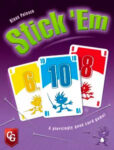
Most trick-takers reward taking tricks. It’s kinda the point, right? Well, sometimes it’s not. While many games include a bidding element where players gain points based on how close they are to their bid, a few games punish players in different ways. Enter… THE PAIN SUIT. In Stick ‘Em, players must pull a card from their hand and place it face up in front of themselves prior to the start of the round, indicating to all other players the suit of card they don’t want to win in a trick, as these cards will cost the player points equal to the value of the cards. This is your pain suit. Naturally, gamers being the kind and helpful souls that they are, assist each other in avoiding the cards that they don’t want. Obviously, that’s not true, gamers are rapacious sharks just waiting to smell blood in the water. If you love to go full Nelson Muntz and ha-ha-ing all over your opponents, this is one of the best games for it. Players collect points for every non-pain card collected in tricks, while collecting negative points for the face value of each pain suit card. In other words, zero is a pretty damn fine score. Stick ‘Em’s plays best at six, in my opinion, though it’s also quite good at lower player counts like three and four. Thankfully, Capstone Games finally gave this early 90s trick-taker an English printing in 2020, and it’s remained in print ever since.
3-8 Players • Ages 10+ • -30-60 minutes • $15
Honorable Mention: Texas Showdown, Thrones of Valeria
Disclaimer: all images are owned and copyright by their respective owners and website (www.boardgamequest.com) and “https://madcity.games/blog” is for news, information, product news and reviews.

